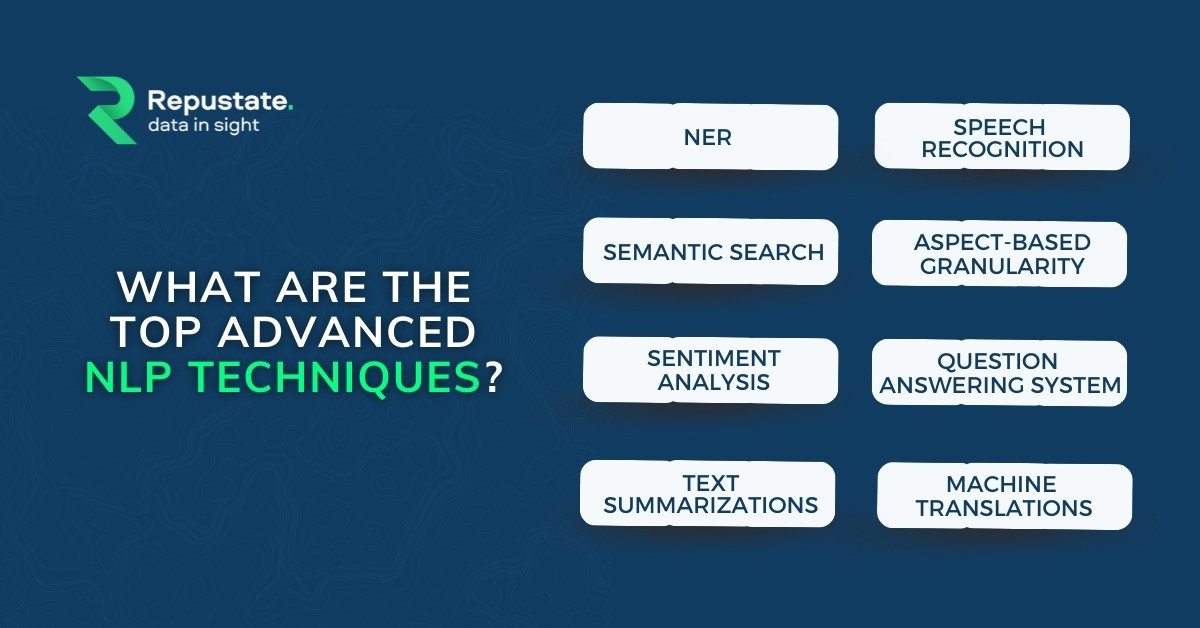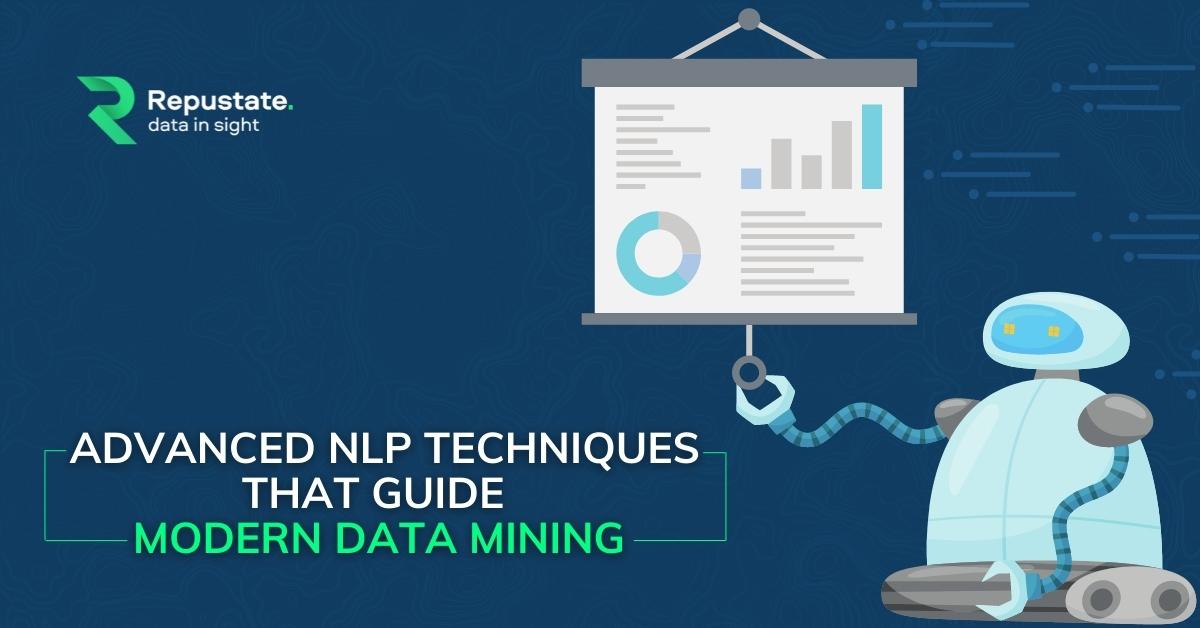Advanced NLP techniques that guide modern data mining
Advanced NLP techniques like named entity recognition (NER), semantic search, text summarizations, sentiment analysis, are top NLP technology tasks that guide the modern data mining industry. In this article we will take a look at these and other important NLP techniques including aspect-based granularity, machine translations and more.
What Is Natural Language Processing (NLP)?
Natural language processing (NLP) is a sub-task of artificial intelligence that analyzes human language comprising text and speech through computational linguistics. It uses machine learning and deep learning models to understand the intent behind words in order to know the sentiment of the text. NLP is used in speech recognition, voice operated GPS phone and automotive systems, smart home digital assistants, video subtitles, sentiment analysis, image recognition, and more.
What Are Top Advanced NLP Techniques?
The most notably used advanced NLP techniques include semantic analysis, emotion mining, named entity recognition (NER), text summarizations, machine translations, and speech recognition. Below we discuss these and more techniques in detail.

1. NER
Named entity recognition (NER) is a machine learning task that processes unstructured data and extracts entities such as people, places, monetary values, objects, brands, medicines, plants, animals, locations, and such. In machine learning, where a model is expected to conduct text analysis or sentiment analysis, NER restricts the ML task to the entities assigned as important. Therefore, each industry domain needs its own NER capability to ensure maximum precision.
2. Semantic search
Semantic search is the part of NLP technology that understands the intention of the user behind a query, searches data for the answer, and then provides it. What sets it apart is intent, without dependency on keywords. Intent here means that the algorithm keeps in mind the user’s search history, past purchases, past online behaviour, location, and other details in order to provide the most relevant information, and thus knows what exactly the user is looking for. The larger the knowledge graph an algorithm has, the more accurate will the answer be.
3. Sentiment analysis
Emotion mining and analysis or sentiment analysis is one of the most widely-used NLP applications in business for consumer and employee insights. Natural language processing tasks analyze data to associate the sentiment with parts of the data that are categorized as entities, topics, or aspects. NLP in video content analysis studies the video and audio data and processes it2 just like text formats. When hundreds of texts such as review comments or social media posts are analyzed for sentiment, the subject of review, for example, a hotel, restaurant, movie, etc, is given an aggregate positive, negative, or neutral score. This NLP task is used frequently in social media sentiment analysis.
4. Text summarizations
Text summarizations are one of those advanced NLP techniques that are used for summarizing text for large documents in industries like aerospace repair and maintenance guides, medical journals, research agencies, and the like. NLP algorithms recognize frequently occurring words and store them. This data is then sorted and categorized. Each sentence in the text is checked for the number of words that have the most frequency, and eventually, chosen and aggregated as the summary of the long document.
5. Speech recognition
Speech recognition is an NLP technology that understands speech and converts it into a text format. Speech recognition software includes real-time captioning or transcription tasks. This is most often used in lectures, conferences, live interviews, news broadcasts for the hearing impaired, video movie streaming services like Netflix or Hulu, and such. The tech can also be used in search inside video applications through voice commands.
6. Aspect-based granularity
Advanced NLP techniques recognize the most relevant entities from gathered data that needs to be processed for sentiment analysis and extract the aspects it identifies. These aspects are scrutinized for user emotions and scored with sentiment polarity. Aspect-based sentiment analysis allows for highly granular sentiment examination of the collected information, such as guest reviews, social media posts and comments, news items, customer service emails, chatbot data, etc.
When this analysis is presented onto a sentiment analysis dashboard, a user can see emotion-aspect co-occurrence. Emotion aspect co-occurrence shows which emotions are most often expressed in relation to which aspect of the subject that is being analyzed. For example, the emotion “love” was expressed 50% of the time with “room” and 80% with “spa”, meaning the guests liked the spa experience more than the room they had stayed in.
7. Question answering system
The question answering system is an NLP task where the algorithm can extract information from data such as text documents, video data, call logs, online search history, image repositories, and more to answer a query asked by a user. This NLP technology helps extract useful information from big data such that the user gets the most precise information. The tech is frequently used in chatbot systems for customer service requirements to make the customer experience more efficient.
8. Machine translations
Machine translations are perhaps the most commonly used of the advanced NLP techniques in the market. This application is used by Google and other search engines, including phones to translate millions of words daily. Machine translation, although not perfect, has played a crucial role in bringing the world a lot closer by giving people the ability to understand texts that are not in a language they are familiar with. From recipes, to song lyrics, to understanding user manuals, machine translations help people decode information that they wouldn’t have been able to otherwise. This NLP technology is also used on gadgets that can translate speech automatically into the language the user has specified.
Leverage NLP Technology With Repustate
A sentiment analysis API uses almost all of the advanced NLP techniques mentioned above and more, to help brands find the information they need to increase their productivity and return on investment. Repustate’s all-in-one sentiment analysis platform, Repustate IQ, uses natural language processing and machine learning to process data in all formats - video, audio, text, and images - to give the most accurate results. Its multilingual capability stems from part-of-speech taggers that are uniquely built for each of the 23 languages it supports. Repustate IQ does not use translations to convert one language into another for the purpose of analysis, but rather reads the data natively.
Furthermore, its NER capability is highly advanced and extremely rich, supporting all major industries including retail, government, banking, automotive, hospitality, finance, and others. The platform reads social media listening data seamlessly and as easily as it does video or document thanks to advanced NLP techniques. The solution understands all the complexities of social media such as abbreviations, special characters, hashtags, code switches, emojis, and colloquialisms.
Conclusion
NLP technology can help companies gain business intelligence to discover new product roadmaps, boost employee morale, increase customer service efficiency and thereby customer loyalty, help in market research, and numerous other functions.
 Home
Home
 Nov 30, 2021
Nov 30, 2021

 Jeremy Wemple
Jeremy Wemple
 Dr. Ayman Abdelazem
Dr. Ayman Abdelazem
 Dr. Salah Alnajem, PhD
Dr. Salah Alnajem, PhD
 David Allen
David Allen

 Repustate Team
Repustate Team

